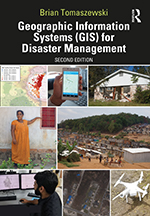
|
Exercise 6-1: Hot Spot Analysis and Visualization of Conflict Events |
This is the companion website for Exercise 6-1: Hot Spot Analysis and Visualization of Conflict Events from the book Geographic Information Systems (GIS) for Disaster Management (second edition). This page contains video walkthroughs of the exercise, datasets associated with the exercise, and other additional materials.
Follow this link to access Exercise 6-1: Hot Spot Analysis and Visualization of Conflict Events datasets:
About Exercise 6-1: Hot Spot Analysis and Visualization of Conflict Events
Skill Level: intermediate
Estimated time to complete: 2-3 hours
Additional resources needed: an Internet-connected computer, a zip tool, ArcGIS Pro 2.x. (Will need Spatial Analyst or 3D Analyst license to complete Task 6. Task 6 is an optional task.) an internet-connected computer, a zip tool, Exercise 6-1 datasets you can download here.
Purpose: the purpose of this lab will be for you to gain experience and knowledge of conducting a Hot Spot Analysis using Getis-Ord Gi*.
Additional notes:
- This exercise will only work with Esri’s ArcGIS Pro 2.x. To obtain a 21-day free evaluation of ArcGIS Pro, see https://www.esri.com/en-us/arcgis/products/arcgis-pro/trial
- This exercise assumes some rudimentary knowledge of statistics. It is beyond the scope of this book and exercise to teach basic statistics concepts (P-score, Z-score). For more information on basic statistics, see https://open.umn.edu/opentextbooks/textbooks/introduction-to-statistics
Learning Objectives: after completing the exercise, you will know:
- how to form a hypothesis about a spatial problem;
- how to test a hypothesis using a spatial statistic;
- how to combine various spatial analysis tools (Integrate, Collect Events, Incremental Spatial Autocorrelation [ISA]) to conduct a hot spot analysis via Getis-Ord Gi*;
- how to visualize the results of your hot spot analysis using the Inverse Distance Weighted (IDW) technique.
Deliverables: if you are completing this exercise for a class assignment, you can submit a screenshot of your response to the instruction questions.
Overview: located in central East Africa, the Democratic Republic of Congo (DRC) has had a turbulent history of conflict over the last 30 years. Conflicts in the DRC stem from a variety of factors such as spillover of refugees after the 1994 genocide in Rwanda that, among other events, are the roots of various civil wars that have occurred in the eastern part of the country, causing both internally displaced people as well as refugee outpouring into neighboring countries . The huge country also has a variety of natural disaster risks such as mudslides, volcanoes, droughts, and flooding that are made worse by existing conditions of political instability and poverty. As of 2019, the eastern part of DRC was also suffering from an outbreak of Ebola. In this exercise, you will do a hot spot analysis of armed conflict events in the eastern part of DRC as part of a hypothetical natural disaster and humanitarian emergency planning process to understand which spots within DRC are statistically significant in terms of susceptibility to the effects of natural disasters and armed conflict. Additionally, such an analysis could be used to determine which parts of the country may be origin points for refugees who are fleeing violence and/or natural disasters in terms of planningfor refugee influx into neighboring countries, a planning activity that is common to organizations like UNHCR discussed in Chapter 5 of the book.
For detailed exercise instructions, purchase the book from Routledge Press »
Exercise 6-1: Hot Spot Analysis and Visualization of Conflict Events Video Walkthroughs
Part 1 of 3: ArcGIS Pro Walkthrough
Part 2 of 3: ArcGIS Pro Walkthrough
Part 3 of 3: ArcGIS Pro Walkthrough